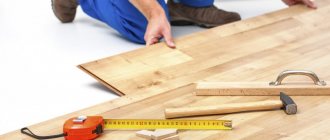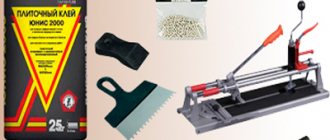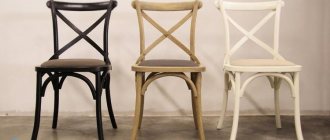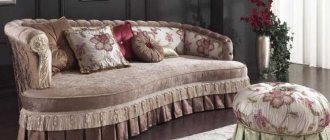People who have a passion for carpentry, in most cases, make light objects to fill their hands. When you already have more experience, you need to start creating more complicated objects, for example, you can make a strong chair that is necessary for the household.
Before starting work, it is advisable to get acquainted with a large assortment of chairs from which you can choose the one you like for DIY craftsmanship.
Each type of chair has its own design and specific use for the owner.
Home chair
The most popular chairs are massive types made of high-quality wood. A DIY wooden chair will last a long time and is suitable for a private home with a similar style. The only downside of this chair is its weight, but it is stable and can withstand any load.
To make a wooden and solid chair with your own hands safe, you need to thoroughly clean the corners and edges.
Notes
- Chair // Ozhegov’s Explanatory Dictionary. S. I. Ozhegov, N. Yu. Shvedova. 1949-1992.
- ↑ 123
Chair - article from Vladimir Dahl's Explanatory Dictionary of the Living Great Russian Language (2nd ed., 1882) - Chair // Ushakov’s Explanatory Dictionary. D. N. Ushakov. 1935-1940.
- Chair // Explanatory Dictionary of Efremova. T. F. Efremova. 2000.
- ↑ 123
GOST 20400-2013 Furniture production products. Terms and Definitions - ↑ 123
Classification and assortment of furniture - Armchair // Ushakov’s Explanatory Dictionary. D. N. Ushakov. 1935-1940.
- Armchair // Explanatory Dictionary of Efremova. T. F. Efremova. 2000.
- Bobikov P.D.
Constructive solutions for chairs // Furniture design. - Moscow: Higher School, 1972. - ↑ 1234
The chair and the history of the development of Russian interior design - Goths in Crimea (undefined)
(inaccessible link). Retrieved February 27, 2020. Archived March 4, 2020. - “Chair” (inaccessible link) (inaccessible link since 06/14/2016 [1436 days]), School Etymological Dictionary of the Russian Language (Retrieved September 27, 2009)
- Setkov, Nikolai Alexandrovich.
Etymo-encyclopedic dictionary for the curious. - Krasnoyarsk: Claretianum, 2005. - Ekaterina Nevolina.
An extraordinary story of ordinary things. - OLMA Media Group, 2004. - pp. 30-33. — 192 p. — ISBN 5-224-04466-9. - Sobolev, p. 10.
- Weiss, 1998, vol. I, pp. 82-83.
- Killen, 1994, p. 11, 27.
- ↑ 12
Antiques. The most complete history of antiques, 2001, p. 28. - Weiss, 1998, vol. I, pp. 171-173.
- Weiss, 1998, vol. I, p. 253.
- Weiss, 1998, vol. I, pp. 521-523.
- Weiss, 1998, vol. I, pp. 716-717.
- Sella // Real Dictionary of Classical Antiquities / author's compilation. F. Lubker; Edited by members of the Society of Classical Philology and Pedagogy F. Gelbke, L. Georgievsky, F. Zelinsky, V. Kansky, M. Kutorga and P. Nikitin. - St. Petersburg, 1885.
- Sobolev, p. 39.
- Weiss, 1998, vol. II, p. 557.
- Weiss, 1998, vol. III, pp. 290-291.
- Weiss, 1998, vol. III, p. 308.
- Weiss, 1998, vol. III, pp. 552-553.
- Antiques. The most complete history of antiques, 2001, p. 29.
- Antiques. The most complete history of antiques, 2001, p. 37-38.
- Antiques. The most complete history of antiques, 2001, p. 53.
- ↑ 1 2 Sidelnikova, Maria
.
Chairs in the morning, chairs in the evening, Kommersant - Style
, kommersant.ru (December 16, 2015). Retrieved December 19, 2015. - Bent furniture Thoneta
- ↑ 123
Russian furniture - N. Ikonnikov
Russian furniture in the 1820s-30s: Empire style Archival copy dated December 22, 2020 on the Wayback Machine // Almanac “Russian Antiques” - Furniture of the first quarter of the 19th century according to architects' designs (inaccessible link)
- ↑ 1 2
History of furniture
(unspecified)
(inaccessible link). Retrieved December 19, 2020. Archived December 22, 2020. - National Romanticism (inaccessible link)
- ↑ 12
Encyclopedia of Home and Family, 2002, pp. 188-190. - "Anatomy" of a carpenter's chair
- ↑ 123
Chairs, armchairs, banquettes, stools, benches - All-Russian Product Classifier (1993) - Chairs: from century to century... wicker chairs.
- ↑ 1 2 3 4 5 Kulebakin G.I., Shepelev A.M.
Chairs and armchairs // Carpentry. — Stroyizdat. - Carpenter's chairs (undefined)
(inaccessible link). Retrieved December 19, 2020. Archived December 23, 2020. - Bobikov P.D. Furniture design. Chapter X. Basic design solutions for furniture products. § 41. Design solutions for chairs. Carpenter's chairs.
- ↑ 12
Bent and collapsible chairs - Manufacturing of carpentry chairs and stools
- Bobikov P.D. Furniture design. Chapter X. Basic design solutions for furniture products. § 41. Design solutions for chairs. Fig. 160. Bent chairs (left)
- Concise encyclopedia of household management. - M.: Great Soviet Encyclopedia. Ed. A. F. Akhabadze, A. L. Grekulova. 1976.
- Bobikov P.D. Furniture design. Chapter X. Basic design solutions for furniture products. § 41. Design solutions for chairs. Rice. 155. Scheme for testing chair durability
- GOST 12029-93 Furniture. Chairs and stools. determination of strength and durability
- Bar stools in the interior (undefined)
. koffkindom.ru. Retrieved December 16, 2020. - From the life of four-legged animals - a chair
- Saddle chair (undefined)
(inaccessible link). smartstool.ru. Retrieved December 16, 2015. Archived December 22, 2020. - Duran, Julia
.
Cantilever, Kommersant Weekend
, kommersant.ru (October 14, 2011). Retrieved December 19, 2015. - Viennese chair - timeless elegance and Austrian charm (undefined)
. worlds-interior.ru. Retrieved December 16, 2020. - History of the Vienna Chair
- Klismos chair
Chair with soft seat
A chair with a soft seat will look more elegant and modern. This type is used in city apartments.
The chair does not look as bulky as the previous one, thanks to thinner legs and back.
Story
Chair from a New Kingdom tomb
The ancient Egyptians may have been the inventors of the chair as a seat with a backrest[14]. The oldest chairs found date back to the III dynasty of Ancient Egypt (3rd millennium BC)[15]. The oldest and simplest chairs in ancient Egypt were massive, cubic in shape; later, under the influence of relations with Near Asia, chairs of more complex shapes, with figured legs and pillows, as well as folding chairs with leather seats and metal stools began to be used[16 ]. The oldest chair drawings found date back to the Second Dynasty, and show simple chairs with straight legs and backs and a cushion to cushion the seat.[17] Chairs and stools with legs arranged crosswise (like scissors) were common[18]. Assyrian chairs show a change in shape from intricate (rounded and curved shapes, legs in the shape of an animal's leg) to simpler shapes - a rectangular connection of straight legs with a seat. At the same time, chairs and throne chairs, like other Assyrian furniture, were richly decorated with carvings, overlays made of bronze and precious metals, and covered with carpets. In the homes of ordinary people, folding chairs were more often used, and they were also, at least sometimes, covered with carpets[19]. After the spread of the custom of reclining at meals in the Ancient East, the custom of eating at the table, sitting on chairs, benches, armchairs, etc. did not disappear, so chairs remained in use everywhere[20].
Ancient Greek chair
In ancient Greece of the archaic and classical periods, chairs, armchairs and stools were completely similar to Assyrian, Egyptian and other ancient Eastern furniture. Chairs could not only be covered with skins or carpets, but also upholstered with pillows. Along with high chairs, footstools made in the same style were used. The fashion of reclining at meals, which spread in post-Homeric Greece, made chairs and other types of seating more of a piece of furniture for the female half of the house (women and children still ate while sitting)[21]. In ancient Rome, as in ancient Greece of later periods, the chair was also predominantly women's furniture; folding lightweight chairs were used in theaters when there were no benches. There were seats of various shapes - both with a back without handles or with a back and with handles, and with handles without a back; the base of the chair could be made in the form of a box or cylinder[22][23]. Chairs woven from willow twigs were mass-produced[24].
The seating of medieval Europe largely copied Roman designs, but throne furniture sometimes had Indian or East Asian influences. Since the 12th century, new types of chairs have appeared - large round or polygonal, with a back that wraps around the seat on almost all sides (for a hexagonal seat - on three or even five sides). The void between the legs was often covered, and sometimes figures of animals were placed under the seat[25]. Although there were various types of chairs, armchairs and stools, chests were regularly used for seating until the 16th century.[26] In the 15th century, chairs with swivel seats, as well as chairs on wheels, were invented[27]. In the 16th century in Europe, seats and backs made of reeds began to be used for cheap furniture; simple armchairs and chairs became more widespread, displacing benches and chests as the main room furniture[28].
In medieval Europe, the design of the chair for special occasions was complemented by a canopy; the Italian version of the cruciform canopy chair is known as the Savonarola chair[18].
Viennese Thonet chair
In the 17th century, cruciform chairs were made in Holland for everyday seating; in England, France and Germany, such chairs were used mainly for ceremonies[29]. At this time in England, upholstered chairs were replacing simpler wooden chairs in the homes of the aristocracy; The most common chairs were upholstered in the farthingale style, which had a gap between the back and the seat so that women wearing a whalebone skirt could sit on such a chair. The chair becomes an indicator of status; the largest chair in the house was intended for the head of the family[30].
In the 18th century, “Windsor chairs” became widespread in England - a type of rural furniture with straight, simple turned legs and a back made of thin turned rods[31].
In the middle of the 19th century, the Viennese furniture maker Michael Thonet adapted for factory production the technique of bending wood under steam, which had previously been used in the manufacture of the “Windsor chair” (a peasant chair in England in the 18th century). The high strength and constructive appearance of the new “Viennese furniture”, together with the technologically advanced and cheap production method, led to the fact that the “Viennese chair” (“bistro chair”) became one of the most successful mass products in the history of industrial production. By 1930, more than 50 million Viennese chairs had been sold.[32][33]
In Russia
Until the end of the 17th century, chairs, like armchairs, were not very common in Russia. By this time, the traditional benches in the reception rooms of the royal palace were replaced by a row of chairs standing against the wall, which was one of the first steps towards the general Europeanization of Russian interior design. In Peter's time, the chair became a common piece of furniture, but it ceased to be perceived as honorable furniture, which should have a proper and permanent place in the room[10].
By the middle of the 18th century in Russia, seating furniture was not very diverse; in general, there was still a shortage of furniture for residential premises. Forms from the beginning of the century (“Petrine Baroque”) were still widely used, in particular, oak chairs with high backs[34].
At the beginning of the 19th century, with the departure from classicism, the chair again moved away from the wall and the side view of the chair became no less important than the front view. Architect V. P. Stasov (1769-1848) at the end of the 1810s invented a new design of a chair and armchair with an expressive profile - the so-called “side frame”. With this design, the front and rear legs and backrest pillars form a single side frame, two such frames were connected to each other by two transverse bars, and the backrest pillars were connected by a transverse plane; the sides were lined with veneer so that the impression of a solid piece of wood was created. For such chairs, an inset seat in the shape of a trapezoid was used. The design created an interesting silhouette and at the same time was so simple to manufacture, durable and comfortable that chairs and armchairs with a side frame became the favorite and almost the only form for thirty years - both in noble and merchant houses[10][35][36] .
In the 19th century, chintz was first used for upholstery of chairs[37]. In the middle of the century, the growing urban population required a huge number of chairs, factory production of furniture was spreading[10], specialized stores appeared where you can, without contacting a craftsman, choose a ready-made chair or select a backrest for a chair frame from available parts[34].
In the last third of the 19th century, furniture in the “Russian style” became popular. Dining chairs in this style were heavy, rectangular in shape, decorated with carvings, and leather and brocade were used for upholstery[37]. In fact, the desire to imitate folk forms in the absence in ancient Russian and folk furniture of not only chairs, but also movable objects in general, led to the fact that armchairs and chairs “à la russe”
were similar in form to European furniture of the late Renaissance or early Baroque, and only the carvings decorating the chairs actually took inspiration from the patterns of folk embroidery and ornaments.[38]
At the end of the 19th century, furniture by P. Gambs, close to Rococo forms, became popular. Gumbs chairs with soft quilted backs were comfortable[34].
Folding chair
This type is used both in the house and on the veranda. It is convenient and compact. It can be easily put in the car for transportation.
It has a complicated design, so to make this option yourself, read additional information about it. The strength of this chair should be higher. If it is made correctly, it will last a long time.
Chairs in culture
Van Gogh, Vincent Chair with Pipe
- "Vincent's Chair with Pipe", located in the London National Gallery, was painted by Van Gogh in the last quarter of 1888 in Arles, paired with "Gauguin's Chair".
- The Twelve Chairs is a repeatedly filmed novel by I. Ilf and E. Petrov. The plot is based on the search for a set of chairs made by the descendants of the famous furniture maker Gambs.
- “Dedicated to the Chair” - a poem by I. Brodsky in 1987:
What do we know about the chair, besides what was said in the heat of controversy? - that all four of it stands, just like your table, on the floor? But the table is a plane that cuts the chest. And your chair is vertical.
- One and Three Chairs - installation by Joseph Kosuth (1965).
How to build a chair with your own hands
How to make a chair with your own hands? When you choose the type of chair, you need to make drawings and size calculations, it is advisable to also look at similar photos of chairs with your own hands.
It is recommended to sign the dimensions on the drawings. For clarity, you can draw all the parts of the chair.
Tools
To build wood furniture you will need some tools. The best processing of furniture will be with the use of good machines. But if you do not have professional equipment, then you can use ordinary hand tools.
For comfortable work you can rent:
- Electric jigsaw. For high-quality cutting of elements.
- Manual frezer. For processing and making grooves.
- Screwdriver. Replaces screwdrivers and drills.
- Sander. For fast processing.
- Clamps of different sizes. To connect elements.
- Hammer.
- Square.
- Ruler.
- Roulette.
- Pencil.
- Knife.
- Pliers.
- Prepare a place with good lighting.
If you want to make your favorite piece of furniture at home, you need to know that without some tools it won’t be easy. Some work is simply not realistic to do, and some will take a lot of time and nerves.
Therefore, if you want to start carpentry, you need to first purchase the most necessary tools.
There is an option to find recommendations for making furniture from unusual materials that do not require the tools listed above. This is for those who don't want a DIY wooden chair.
Design
Console chair
The main parts of the chair are the seat
,
back
(
rest
,
shield
) and
legs
.
Auxiliary parts - drawers
(elements that fasten the legs of a chair under the seat, can also serve as a support for the seat),
legs
- elements connecting furniture legs at the bottom,
bosses
(angles).
The part of the backrest on which the seated person directly rests his back is called the backrest
. Traditionally, a chair has four legs, either individual or linked in pairs in a scissor design (X-shaped design). The number of legs can vary; there are models of chairs without separate legs - for example, a cantilever chair. The legs, drawers and legs together make up the frame of the chair. The back of the chair can be structurally a continuation of the rear legs or be a separate element. It can be solid, through or inlaid (rack and pinion). The main parameters of the chair are the overall height (along the back) and the height, width and depth of the seat. The height of the chair seat is determined by ease of use in relation to the height of the table. In terms of rigidity, chairs can belong to any of the categories of furniture - hard, semi-hard, semi-soft and soft; the back can be the same hardness as the seat, or more rigid. The style of chairs is determined, first of all, by the height, design and shape of the back, as well as the design of the seat, the shape of the legs, etc.[5][39][6][40]
According to the main material and manufacturing method, chairs are divided into carpentry chairs (parts are cut from solid coniferous or hardwood), bent or bent chairs (from hardwood wood bent under steam), wicker chairs (from willow rods, as well as rattan, reed, straws, vines), metal (including those combined in material). The Russian product classifier also distinguishes laminated chairs (bent-glued, using the technology of bent chairs, but to reduce the cost, solid wood rods are replaced with bent veneer) and mixed construction, and separate categories by purpose - children's chairs and piano chairs. In addition, chairs can be made by casting (molding) from plastic or glass; glued chairs, in addition to bent-glued ones, can be flat-bonded - with plywood-based frames. Wicker chairs also include stick chairs - made from sticks and other materials[6][41].
The material and design of chairs influence their use. Plastic chairs are lightweight and often have a design that allows one chair to be “strung” on top of another, saving space. This makes them well suited for organizing public events outside of permanent premises. Wicker chairs are often considered "rustic" furniture.[42]
Design Features
Legs
. To make the chair more stable, the front legs are usually spaced further apart from each other than the back legs, and the back legs lean back at the bottom.
Tsargi
. Drawers are usually placed on four sides, but there are chair designs that use only side drawers. In such chairs, the missing drawers are replaced by a common box that forms the seat[43][44][39].
Seats
. Seats can be frameless (panel, made of solid boards, particle boards, thick plywood) and framed (especially for flexible or elastic bases), according to the method of installation - straight and with a bevel to the back, overhead (overlaid on drawers) and inset, mixed is also possible type. By design: frame or panel - with elements from individual boards. The shape of the seat is round, horseshoe-shaped and trapezoidal, flat, convex and concave.
Backrests
. The backs of chairs can be flat or curved in shape, regular or shortened in height (lumbar back). They can be solid, through and slatted (from a set of bars that form a lattice, frame or supporting plane). For chairs without a solid back, the gap between the back and the seat can be filled with a decorative element. For a chair to be comfortable, its back must have a sufficient tilt back.
Leggings
. Legs can be high or low. The high leg is located in the plane of the front legs, while the low one is recessed at least 180 mm from the plane of the front legs so that the person sitting on the chair does not break the leg with their feet. Usually, a leg is not placed between the rear legs, since the back itself creates a fairly rigid structure. As tests conducted at VPKTIM have shown, the absence of legs reduces the strength of a chair by half (50%), so chairs without legs are made with thicker legs and wider drawers[45]. It is possible to use a cross-shaped structure instead of longitudinal and transverse struts.
Carpenter's chairs
. Hardwood is more often used for carpenter's chairs. Chairs made from coniferous wood, which is less durable, are more bulky. Joiner's chairs, in which the back legs extend into the back, are called chairs with solid back legs; joiner's chairs, in which the back legs and vertical bars of the backs consist of different parts, are sometimes called chairs with attached back legs. The parts of carpentry chairs are connected mainly using tenons and glue[43][46][47].
Bent chairs
. The design of bent furniture is simpler than carpentry. Bent chairs do not have sharp corners; mainly parts with a round cross-section are used, curved according to a given profile. Bent chairs usually have back legs that extend into the back. Drawers and legs are bent. The drawers are made from one closed part, bent into a ring or into a trapezoid or some other shape, or from two parts: a front drawer and a horseshoe drawer, which replaces two side drawers and a rear drawer. The legs can also be closed in a ring or horseshoe-shaped. More durable are chairs with bent legs in the form of horseshoes, fastened with two outer screws to the legs, and with a third central screw to the drawer. Even more durable are chairs that have two bent brackets, fastened with two screws: one to the back leg above the seat, and the second to the side drawer[48]. The seats are made slightly concave, from plywood 4-5 mm thick. The parts of bent chairs are connected mainly using screws and two wood grouse[43][46].
Glued and bent chairs
. For bent-glued chairs, both the main elements separately and their block from the back together with the seat, made in the form of a single element, can be glued.
Flat adhesive chairs
. In flat-glued chairs, in a similar way, both the main elements individually and their blocks from a pair of legs forming the side can be glued [43].
Rigidity
The rigidity of a seat is determined by its design. A hard seat is usually made of wood (plywood, boards, or solid). The comfort of a hard seat is achieved by a slightly concave shape in the middle. A semi-rigid seat is made by applying a small layer of padding (5 - 7 mm) to a hard seat. The padding is covered with upholstery material - fabric, leather, oilcloth or leatherette. Horse hair, hemp, seaweed, cotton wool and other materials are used for stuffing. Semi-hard seats also include wicker seats made of reeds, woven braid, strips of leather, etc. A semi-soft seat is made by applying a layer of padding 40-60 mm thick onto a hard or woven braid base. The padding is covered with fabric or leather. The soft seat is made using microporous rubber or foam rubber with a thickness of 50-100 mm as padding, or by installing a spring system between the base and the padding layer.
The most common chairs are those with rigid and semi-rigid seats and backs[43][49].
Characteristics
One of the main requirements for chairs is strength. Considering that chairs operate in the most difficult conditions compared to other types of furniture, and their design consists mainly of parts of a rather small cross-section, the compliance of the chair design with strength requirements must be confirmed by laboratory tests.
Before putting them into production, new chair designs are tested for durability, which, in accordance with GOST, is carried out on a special stand with a cyclic load.[50][51].











